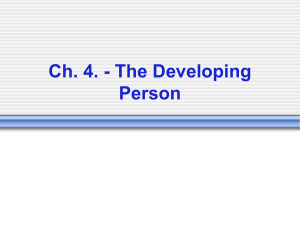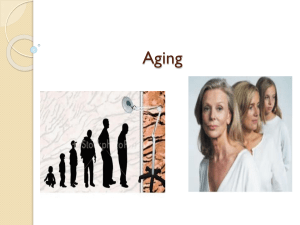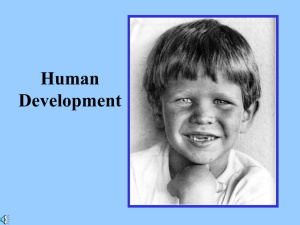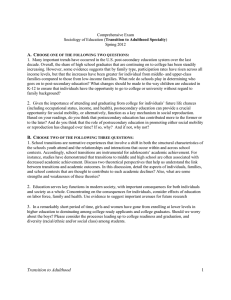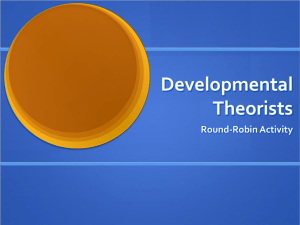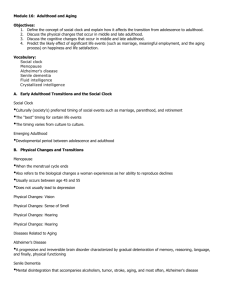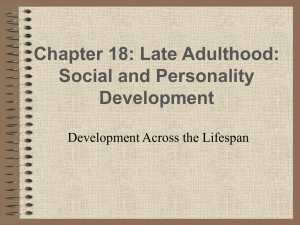Psychology 3533 Understanding Human Sexuality
advertisement
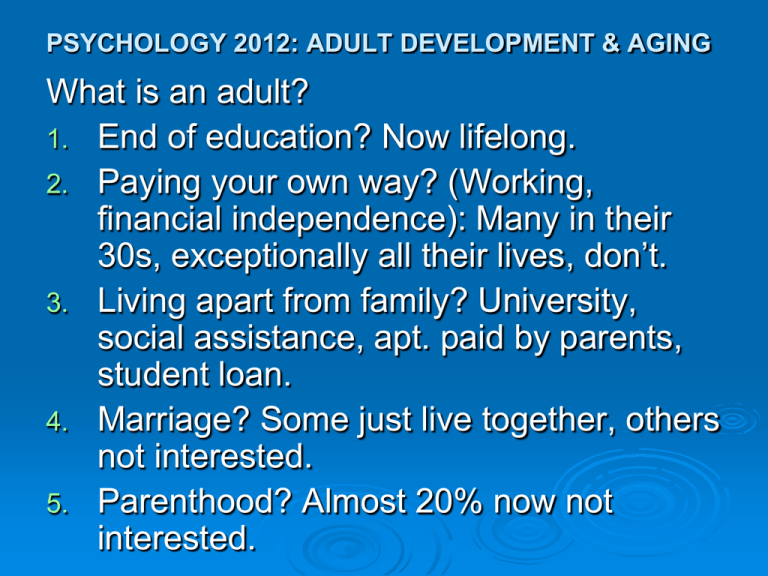
PSYCHOLOGY 2012: ADULT DEVELOPMENT & AGING What is an adult? 1. End of education? Now lifelong. 2. Paying your own way? (Working, financial independence): Many in their 30s, exceptionally all their lives, don’t. 3. Living apart from family? University, social assistance, apt. paid by parents, student loan. 4. Marriage? Some just live together, others not interested. 5. Parenthood? Almost 20% now not interested. What is an adult (Cont’d)? • “Social Clock” no longer runs on time. • Impact of need for more education. • Beginning of adulthood: Between 20-25 to end of life: about 60 years. • Young adulthood: 20-40. First and second decade. • Middle adulthood: 40-65 What is an adult (Cont’d)? • Old adulthood: 65-death. • • • • Young-old: 65-75 Old-old: 75-85 Very old: 85+ Young adults: • • • • • establish identity: who am I? What do I want? Evolving. choose field of work, acquire qualifications, start job. find spouse. become parents. conflict between intimacy and independence What is an adult (Cont’d)? Middle adults: • settle in and advance in chosen field of work • take care of family needs • generativity (guiding next generation) • take care of aging parents • achieve maximum potential • grow financially • continue identity development • prepare for retirement and old age Older adults: • adjust to retirement • adjust to changing capabilities • choose appropriate housing • prepare and adjust to spouse’s death • • • The terms development and age have undergone substantial change in the past two decades. Development: used to refer to changes of growth and increased complexity. Aging: meant loss, decay, trend toward simplicity. • • • Current view: growth and complexity continue into old age, while loss can begin at birth (at the cellular level at least). Development now refers to any agerelated change in body or behaviour. Age-related is not the same as age caused. Can principles of development explain the changes that occur throughout the lifespan? DEVELOPMENTAL VARIABLES (text: forces) • Biological • • Heredity, health (nutrition, pollution, etc.), anything physical Psychological • • Cognitive, emotional, behavioural, personality (temperament) and variables derived from those. Sociocultural • • Social and cultural environment, ethnicity, religious beliefs and practices Life-cycle • Interaction of all the above with each life stage of each individual AGE CAN BE: • Chronological (time since birth) • Biological (physical wear and tear) • Social (benchmark roles) • Psychological (emotional maturity, identity development, memory status, etc.) • • • • Development: age-related changes Primary Aging: normal aging (wrinkles, gray hair, slower CNS) Secondary Aging: changes due to lifestyle, disease, etc. (overweight, smoking, no exercise) Many aging problems due to secondary aging not inherent to aging per se. 1900 OLD YOUNG CHILDREN 2000 OLD YOUNG CHILDREN CHANGES IN LIFE EXPECTANCY 1 AD – 35 1900 – 46-48 2005 – 78-82.7 Of the 10 Canadian provinces, NL has the lowest life expectancy *Also important: How many years after 50 have good quality of life? Two countries with the same life expectancy could have different figures e.g. UK (women): life expectancy: 82.7~ healthy years after 50: 20.8 France (women): life expectancy: 85.4 ~ healthy years after 50: 19.7 CHANGES IN LIFE EXPECTANCY • Reasons for increase: • • • • sanitation nutrition medical advances Consequences: • • • • demographics marriage/divorce career/retirement/second career lifestyle of the old • Scientific interest in aging: • • • geriatrics gerontology thanatology CHANGES RELATED TO INCREASED LIFESPAN: • Technological advances • Need for more education • Prolonged childhood/adolescence • Fertility control • Later parenting, fewer children • Attitudinal changes • Health Care APPENDIX There used to be four common life phases: childhood, adolescence, adulthood and old age. Now, there are at least six: childhood, adolescence, odyssey, adulthood, active retirement and old age. Of the new ones, the least understood is odyssey, the decade of wandering that frequently occurs between adolescence and adulthood. During this decade, 20-somethings go to school and take breaks from school. They live with friends and they live at home. They fall in and out of love. They try one career and then try another. Their parents grow increasingly anxious. These parents understand that there’s bound to be a transition phase between student life and adult life. But when they look at their own grown children, they see the transition stretching five years, seven and beyond. The parents don’t even detect a clear sense of direction in their children’s lives. They look at them and see the things that are being delayed. They see that people in this age bracket are delaying marriage. They’re delaying having children. They’re delaying permanent employment. People who were born before 1964 tend to define adulthood by certain accomplishments — moving away from home, becoming financially independent, getting married and starting a family. In 1960, roughly 70 percent of 30-year-olds had achieved these things. By 2000, fewer than 40 percent of 30-year-olds had done the same. Yet with a little imagination it’s possible even for baby boomers to understand what it’s like to be in the middle of the odyssey years. It’s possible to see that this period of improvisation is a sensible response to modern conditions. Young people grow up in tightly structured childhoods, Wuthnow observes, but then graduate into a world characterized by uncertainty, diversity, searching and tinkering. Old success recipes don’t apply, new norms have not been established and everything seems to give way to a less permanent version of itself. Dating gives way to Facebook and hooking up. Marriage gives way to cohabitation. Church attendance gives way to spiritual longing. Newspaper reading gives way to blogging. (In 1970, 49 percent of adults in their 20s read a daily paper; now it’s at 21 percent.) The job market is fluid. Graduating seniors don’t find corporations offering them jobs that will guide them all the way to retirement. Instead they find a vast menu of information economy options, few of which they have heard of or prepared for. Social life is fluid. There’s been a shift in the balance of power between the genders. Thirty-six percent of female workers in their 20s now have a college degree, compared with 23 percent of male workers. Male wages have stagnated over the past decades, while female wages have risen. This has fundamentally scrambled the courtship rituals and decreased the pressure to get married. Educated women can get many of the things they want (income, status, identity) without marriage, while they find it harder (or, if they’re working-class, next to impossible) to find a suitably accomplished mate. The odyssey years are not about slacking off. There are intense competitive pressures as a result of the vast numbers of people chasing relatively few opportunities. Moreover, surveys show that people living through these years have highly traditional aspirations (they rate parenthood more highly than their own parents did) even as they lead improvising lives. Rather, what we’re seeing is the creation of a new life phase, just as adolescence came into being a century ago. But there is every reason to think this phase will grow more pronounced in the coming years. European nations are traveling this route ahead of us. They delay marriage even longer than we do and spend even more years shifting between the job market and higher education. And as the new generational structure solidifies, social and economic entrepreneurs will create new rites and institutions. Someday people will look back and wonder at the vast social changes wrought by the emerging social group that saw their situations first captured by “Friends” and later by “Knocked Up.”
